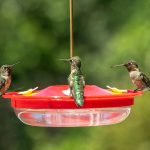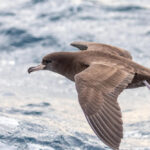During a rainstorm, it is unlikely to see a bird flying around.
However, it is possible to see a hummingbird casually drinking nectar from a feeder while the raindrops fall.
Hummingbirds can fly in the rain. This is because their unique anatomy, which includes jointed wings, allows them to position themselves to shake off water in synchronized movements. This can be done effectively and quickly while flying and hovering. Hummingbirds also have a preening gland, like many other birds. The oil from this gland effectively repels water from the hummingbird’s feathers.

Read on to learn more about these small, but mighty fliers, and how they fly well despite the rain.
Hummingbirds Flying In The Rain

When it’s raining, many birds can often be found hunkered down as they wait for the precipitation to end. Most birds can fly in the rain, but avoid doing so.
However, this is not because they are wet, but rather because there is an atmospheric shift.
Effects Of An Atmospheric Change On Birds
Rainstorms tend to occur when there is low atmospheric pressure. The precipitation and humidity of rain add water molecules to the air, making the air molecules less dense.
Birds need dense air for aerodynamic lift, and therefore need to use more energy to fly in this type of atmosphere.
Additionally, the added precipitation cools the warm-blooded birds down, making them prone to losing body heat.
Therefore, many birds will perch during rainstorms to conserve energy and body heat.
However, hummingbirds are not like most birds. They can fly well in rainy conditions despite changing atmospheric conditions.
3 Reasons Why Hummingbirds Can Fly In The Rain

Hummingbirds, in the Trochilidae family, are tiny, yet powerful fliers. They need to feed often to combat their high energy usage as they fly quickly and to maintain body heat.
Hummingbirds can be seen flying around in heavy rain and windy conditions, drinking nectar from flowers and feeders without any issue.
There are several reasons why they can do so.
1. Aerial Kinematics And Anatomy
Kinematics is the geometry of motion and how forces work on a moving body. Certain physiological attributes allow hummingbirds to fly well and fast.
Anatomy For Fast Flying
Hummingbirds have primarily hollow and porous bones throughout their bodies, including their wings. In this way, they are much like other birds, because these bones make them more lightweight for flying.
Their compact and muscular bodies are connected to wings in a way that is different from other birds. Other birds flap their wings, but hummingbirds have connecting and rotating shoulder joints.
These joints allow hummingbirds to fly up, down, sideways, and backward moving their wings in an oval pattern. However, when hovering they manipulate their wings in a figure-eight pattern.
Hummingbirds have strong pectoral muscles and larger hearts (as compared to other birds) for moving oxygen through their lungs for high-speed energy.
Wing Beat Rates
Larger hummingbird species beat their wings at slower rates than smaller species, however, they continue to be fast.
For example, a tiny, male Calliphlox amethystina (amethyst woodstar) hummingbird beats his wings 80 times per second (p/s). A larger male Archilochus colubris (ruby-throated) hummingbird beats his wings 50 times p/s.
Hovering In Precipitation
Research was done to observe the effects on the hovering performance of hummingbirds in different amounts of rain: light, moderate, and heavy.
- Light: The hummingbirds had virtually no change in their flight movements.
- Moderate: Their wingbeat frequency was reduced by about 7%.
- Heavy: The hummingbirds positioned their bodies and tails more horizontally. They also showed increased wingbeats yet reduced stroke amplitude.
- In this condition, hummingbirds used 9% to 50% more energy than in other hovering conditions.
In cases of severe weather, such as a hurricane. Hummingbirds will shelter, gripping onto surfaces such as the sides of trees away from the wind (leeward) with their strong legs and feet.
They may also settle into dense vegetation while waiting for a heavy storm to pass. As soon as it’s over, or lessens in severity, they fly and start to feed again.
2. Water Shake Off
While at rest and during flight, the hummingbird can shake the water off effectively and quickly, showing great aerodynamic control.
This allows the bird to maintain body heat when it is raining by removing the water from its feathers.
The hummingbird moves its head, body, wings, and tail in synchronized and controlled movements while oscillating its wings in the opposite direction.
It can effectively remove any size of raindrops through these motions, using large, pectoral muscles.
Studies have found that the hummingbird’s wings can position and twist up to 108 degrees out from the body, and flapped 94 times p/s. The head can twist and shake up to 202 degrees at 132 times p/s.
These fast speeds quickly displace the water.
The frequency of shakes is higher for aerial shaking than for perching.
This video shows a hummingbird shaking off water from both a perched position and while hovering:
3. Oiled Feathers
Hummingbirds, like many other birds, have feathers that repel water.
They have a uropygial (preening) gland located at the top of the base of their tails.
When the hummingbird preens itself it ruffles its feathers first. Then it uses its beak to remove debris, parasite, dust, and more from the feathers.
During this process, the hummingbird will take droplets of oil from the uropygial gland and work in fresh oil.
The way that oiled feathers lie on a bird’s body also allows water to roll right off.
In addition to preening, the hummingbird will use water (such as that from rain) to help smooth its feathers for efficient flight.
In Conclusion
Hummingbirds can efficiently and quickly fly in the rain.
This is because they have jointed wings that they can move in oval and figure-eight patterns while flying and hovering.
When wet, hummingbirds will rotate their heads and wings in synchronized movements to displace water.
Hummingbirds also preen using oil from a gland near their tail feathers. This oil also effectively repels water.
Read More About Hummingbirds:
- Can Hummingbirds Fly Backwards?
- Can Hummingbirds See In The Dark?
- Can Hummingbirds Open Their Beaks?
- Where & How Do Hummingbirds Sleep?
- Do Hummingbirds Play Dead?










![Do Sparrows Eat Sunflower Seeds? [Favorite Types Explained] Do Sparrows Eat Sunflower Seeds? [Favorite Types Explained]](https://birdchronicle.com/wp-content/uploads/2022/10/sparrow-eating-seeds-on-hand-150x150.jpg)

